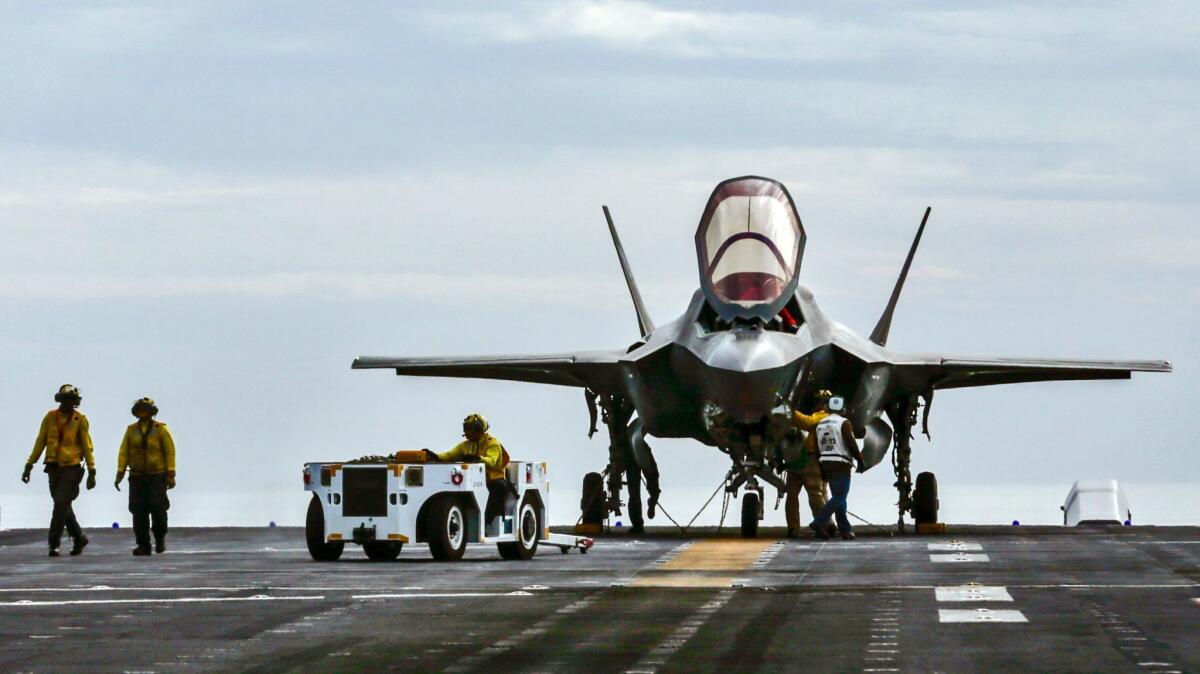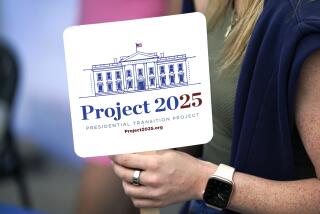Q&A: Best advice for Lockheed on the F-35? âMake Trump look bigâ

The F-35 Joint Strike Fighter program canât seem to escape the crosshairs of President-elect Donald Trump.
In his first news conference since the election, Trump on Wednesday slammed the aircraft program, saying it is âway, way behind schedule and many, many billions of dollars over budget.â
He added, âWeâre going to do some big things on the F-35 program, and perhaps the F-18 program.â In December, Trump tweeted that he had asked Boeing Co. to price out a âcomparableâ F-18 Super Hornet. That came shortly after another tweet criticizing the F-35 programâs cost as âout of control.â
Built by defense giant Lockheed Martin Corp., the plane has been controversial from the start. It is a so-called fifth-generation fighter thatâs a bit like a flying Swiss Army knife â designed to be stealthy, fly at supersonic speeds and use advanced sensors that can link data with ships, drones and other planes.
The F-35 has three variants to serve the unique needs of the Air Force, Marines and Navy. The F-35A for the Air Force will be the most common type of the plane, with conventional takeoff and landing abilities. The F-35B for the Marines can take off from short landing strips and land vertically, while the F-35C for the Navy is built to handle the stress of takeoffs and landings on aircraft carriers.
Over the years, the program has been criticized for cost overruns and production delays. With a total estimated price tag of $379 billion to build 2,457 planes for the U.S. military, it is considered the most expensive weapons program ever, though costs have decreased since 2014. The total cost to maintain the planes over the life of the program has been estimated at more than $1 trillion.
In December, the F-35 programâs executive officer, Lt. Gen. Christopher Bogdan, told reporters that the program would need $532 million more to finish system development and demonstration.
More than 3,000 planes eventually will be built for the U.S. and 11 other countries â unless Trump decides to cut back orders.
The Times spoke recently with Richard Aboulafia, vice president of analysis at the Teal Group, an aerospace and defense market research firm, about the future of the F-35 program under the Trump administration. Hereâs an edited version of the interview.
How much trouble is the F-35 in, given the recent attention from Trump?
Itâs not much. They just have to look contrite and make Trump look big. He likes big government pronouncements that influence private sector companies.
How up to date is that $400-million overrun figure Trump cites for the program?
I think the latest is now a little higher than that. But of course in the broader context of this program, thatâs all chump change. The real story here is the unit [per plane] prices, which are stubbornly high.
Why havenât the unit prices decreased as much as expected?
Itâs just fundamentally expensive and, because youâve got three very different models, the learning curve doesnât look like past programs. These are basically three different aircraft. Theyâre going at a slower pace.
Trump asked Boeing to price out an F-18 thatâs âcomparableâ to an F-35. How much of the stealth and sensor features of a fifth-generation fighter can be added to the 38-year-old F-18 design?
Not really very many. The Super Hornet is a Navy plane, and the Navy decided it preferred the Super Hornet years ago. Thatâs ancient history. And Boeing did spec out an advanced Super Hornet, and it is a pretty interesting product. Stealth isnât its forte but it does have interesting features.
Is this a realistic possibility to replace the F-35?
The advanced Super Hornet is a pretty good plane, and Iâd be surprised if the Navy did not get it. It is also a Navy plane. Weâll know [Trumpâs] serious if he says, âWeâre going to have Boeing and Lockheed scope out F-15s and F-16sâ [for the Air Force]. The real driver behind the F-35 is the Marines. They need a vertical [landing] plane, and thereâs only one of those in production â itâs called the F-35B.
For them, fifth generation is less about stealth and more about creating the first supersonic short takeoff and vertical landing production aircraft.
How about ordering fewer planes? Where would that leave the Navy or Marines?
It would run the risk of a death spiral where costs increase because numbers decrease.
The Navy would throw a party and continue to buy Super Hornets. The Marines would have a heart attack and say, âWhat do we do with nine very big ships [amphibious assault ships designed to accommodate F-35Bs] and our entire forward-looking strategy?â And there would be no answer.
There are 11 other countries involved in the F-35 program, either as production partners or customers. What are the implications for them?
Very big. Many of them have based their defense plans around this plane. So theyâre taking delivery of this plane. The Royal Navy is building two large aircraft carriers on the basis of this aircraft.
Whatâs the lesson for other defense contractors under the new administration? And what should they do if they are singled out?
The No. 1 lesson is to be as humble and contrite as possible. This is an effort by big government to maximize its role in the economy and in decision-making. And when youâre dealing with that kind of big-government approach, the only thing you can do is join with it and make it look as big as it wants to look.
ALSO
VW pleads guilty in emissions cheating scandal; six supervisors indicted
Trump says heâll turn over company to sons but falls short of eliminating ethics issues
Los Angeles County brings in a record-high number of tourists in 2016
More to Read
Inside the business of entertainment
The Wide Shot brings you news, analysis and insights on everything from streaming wars to production â and what it all means for the future.
You may occasionally receive promotional content from the Los Angeles Times.











